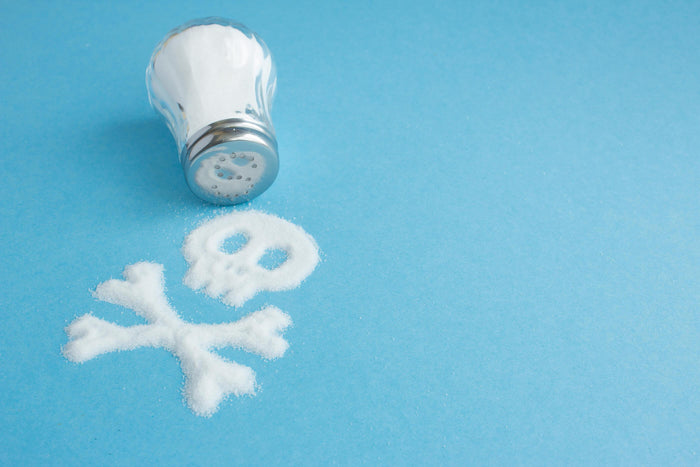March 31, 2017
Why True Lemon is the Answer to America's Salt Crisis

In April of 2010, the U.S. Food and Drug Administration (FDA) announced plans for a 10-year program to limit the amount of sodium that processed food manufacturers can include in their products. The program will start by seeking voluntary cutbacks, but eventually may regulate levels of sodium in food and beverages.
Why does the government think it needs to regulate salt?
Salt is a good thing. People naturally like salt's taste. Cooking with salt reduces bitterness, helps to texture foods, and helps baked foods rise. Salt is also a useful preservative that can stop bacterial growth. And beyond just liking salt, humans require it for basic bodily functions. Sodium helps bodies keep a proper balance of fluids, transmit nerve impulses, and it influences the contraction and relaxation of muscles.
But even for all that work, our bodies only need a very small amount of the stuff.
National health organizations recommend daily sodium limits don't exceed 1,500 to 2,400 milligrams (mg) for healthy adults, and less for those who are older. But on average, Americans eat more than 3,400 mg of sodium daily. That's about 1.5 teaspoons of salt every day.
So what's the matter with eating too much salt?
The answer is plenty. There are some shocking facts about the negative effects of having too much salt in our diets. To begin with, there is "a distinct relationship between sodium and the development of hypertension (high blood pressure) and other life-threatening diseases," said Jane E. Henney, professor of medicine, University of Cincinnati College of Medicine. Henney chaired the Institute of Medicine study that called for federal regulation of sodium in processed foods.
"Excess sodium greatly increases the chance of developing hypertension, heart disease and stroke," said Dr. J. James Rohack, president of the American Medical Association.
In a study published in the New England Journal of Medicine, researchers found that lowering salt intake by three grams a day would cut new cases of heart disease each year by a third and reduce about 100,000 deaths per year. And the study estimates that savings in health care costs would potentially be huge: up to $24 billion annually.
But cutting down those three grams won't happen even if Americans simply put away their salt shakers. Today, 75 percent of the salt Americans ingest is in processed foods and from food at restaurant chains. Right now manufacturers can use as much salt as they want in foods as long as they report the amount on nutrition labels.
For decades, the government has pushed the food industry to reduce salt voluntarily. But food manufacturers haven't been able to reduce salt on their own because they feared losing customers to competitors that decide to keep a higher salt content.
That is where the government's new salt limits come in.
The FDA intends to work with the food industry and health experts to gradually adjust America to a less salty diet. The FDA would analyze the salt in sauces, breads and thousands of other items. Working with manufacturers, the FDA would then set limits in each category, gradually reducing down salt amounts so that consumers barely notice the change.
Less salt in processed foods and restaurant meals is still a long way off. In the meantime, you can take steps to limit salt in your diet.
The American Dietetic Association, which represents almost 65,000 food and nutrition professionals, recommends these tips for reducing salt intake:
- Eat more fresh fruits, vegetables, and whole grains, and lean meats that you cook at home.
- In restaurants, ask for sauces and dressings on the side, since that is where most of the salt will be. Here are some more tips for making healthy choices when dining out.
- Eat smaller portions. Start by using a smaller plate when eating at home.
- Read food labels to see how much sodium is included.
- Cook with herbs and spices and use acids, such as True Lemon or vinegar instead of salt in your recipes.
- Be cautious of salt substitutes, as people with kidney problems may have difficulty with the potassium that is commonly included.
A new alternative: True Lemon and True Lime are healthy salt substitutes!
"True Lemon and True Lime are a great way to season your food instead of using salt," said Diane Henderiks, RD, of Dietitian in the Kitchen. "With no sodium, True Lemon and True Lime are natural flavor-enhancers that your taste buds can appreciate instead of salt."
Henderiks also recommends the National Institute of Health's eating plan, Dietary Approaches to Stop Hypertension (DASH). Click here to learn more about the DASH Diet.
Our sodium free seasoning blends are a delicious way to help cut salt from your diet and support heart health. You can feel good about cooking with True Lemon, True Lime, True Lemon Pepper, True Orange Ginger, and True Lime, Garlic & Cilantro.
Sources:
FDA plans to limit amount of salt allowed in processed foods for health reasons, Washington Post, April 2010
Study Counts Benefits of Cutting Salt Wall Street Journal, January 2010 Statistics: Its Time for an Assault on Salt Chicago Tribune, May 2010
The American Dietetic Association, The Mayo Clinic, National Academy of Sciences Institute of Medicine, and National Institute of Health.
This article was updated with recent information in 2017.

